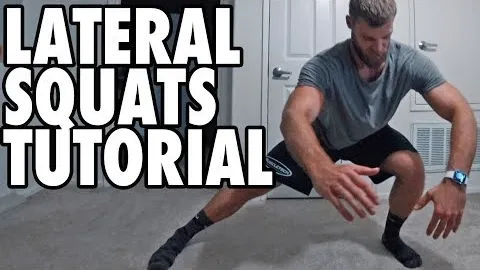
When it comes to lower body workouts, the lateral squat is an exercise that should not be overlooked. This highly effective exercise targets multiple muscle groups, including the glutes, quadriceps, hamstrings, and adductors. Not only does it help build strength and stability in your lower body, but it also improves flexibility and balance. In this article, we will dive into the details of the lateral squat, its benefits, and how to perform it correctly for maximum results.
The lateral squat offers a wide range of benefits for individuals of all fitness levels. Let's take a closer look at some of the major advantages of incorporating this exercise into your workout routine:
Strengthens Lower Body Muscles: By engaging the glutes, quadriceps, hamstrings, and adductors, the lateral squat helps to build functional strength in these important muscle groups. This, in turn, enhances your overall performance in activities such as running, jumping, and squatting.
Improves Hip Mobility: The lateral squat requires a wide range of motion in the hips, making it an excellent exercise for improving hip mobility. Regularly performing this exercise can greatly contribute to better flexibility and range of motion in this area.
Enhances Balance and Stability: Lateral squats target the stabilizer muscles in your lower body, which play a crucial role in maintaining balance and stability. By strengthening these muscles, you can reduce the risk of falls or injuries in daily activities or sports.
Engages Core Muscles: The lateral squat also engages your core muscles, including the abdominals and obliques. While primarily a lower body exercise, the lateral squat provides a great opportunity to work on your core strength and stability.
Helps Correct Muscular Imbalances: Many individuals have imbalances in their lower body muscles, such as having stronger quads than adductors. The lateral squat can help correct these imbalances by targeting the weak areas and bringing them up to speed with the stronger ones.
To reap the full benefits of the lateral squat, it's crucial to perform the exercise with proper form. Follow these step-by-step instructions to ensure you are doing it correctly:
Stand with Feet Shoulder-Width Apart: Start by standing with your feet shoulder-width apart, keeping your toes pointing forward.
Take a Wide Step to the Side: Take a wide step to the side with your right foot, keeping your toes pointing slightly outward. Your left foot should remain planted on the ground.
Shift Your Hips Back and Lower: As you step to the side, shift your hips back and lower your body into a squatting position. Keep your chest lifted and your back straight throughout the movement.
Bend Your Right Knee and Keep Left Leg Straight: As you lower your body, bend your right knee, while keeping your left leg straight. Make sure your knee is not extending beyond your toes and your weight is evenly distributed.
Push Through Your Right Heel and Return to Starting Position: Push through your right heel and engage your glutes and quadriceps to return to the starting position. Repeat the exercise on the other side by stepping to the left.
To make the most out of your lateral squat workout and prevent injuries, consider the following tips:
Start with Bodyweight: If you are new to the lateral squat, begin by performing the exercise with just your bodyweight. Once you feel comfortable and confident, you can gradually add resistance using dumbbells or kettlebells.
Maintain Proper Form: Focus on maintaining proper form throughout the exercise. Keep your chest lifted, back straight, and knees aligned with your toes. Avoid rounding your back or allowing your knees to collapse inward.
Progress Gradually: As you gain strength and improve your form, you can progress to more challenging variations of the lateral squat, such as the lateral goblet squat or the lateral squat with a resistance band. Challenge yourself, but always listen to your body and avoid overexertion.
Combine with Other Lower Body Exercises: To create a well-rounded lower body workout, combine the lateral squat with other exercises that target different muscle groups. Lunges, squats, step-ups, and hip thrusts are great options to consider.
The lateral squat is a fantastic exercise for strengthening and toning your lower body. By incorporating this exercise into your workout routine, you can improve your strength, flexibility, balance, and overall performance. Remember to perform the lateral squat with proper form and gradually increase the intensity as you progress. With consistency and dedication, the lateral squat will help you achieve your fitness goals and unleash the full potential of your lower body muscles.
If you're looking for a gym, fitness club or yoga studio, you've come to the right place.
You can find information about gyms in your area. Browse catalog of gyms and find gyms with classes which are you looking for.
On gym page you can find simple information like address, phone or website. You can find list of available classes. You can check availability of personal training or small group classes. On place page you can also see information about open hours.
You can find gyms near you with amenities, courts, studios and equipments.
Use our map to find gym at your city or district.
In Gym Navigator you can find list of exercises with movies for many body parts.
You can browse exercises catalog and find exercises the best of you.
You can also find exercises grouped into workout plans, which you can use to improve you body. Each routine show you exercises one by one and give you possibility to count you progress and count down rest time.